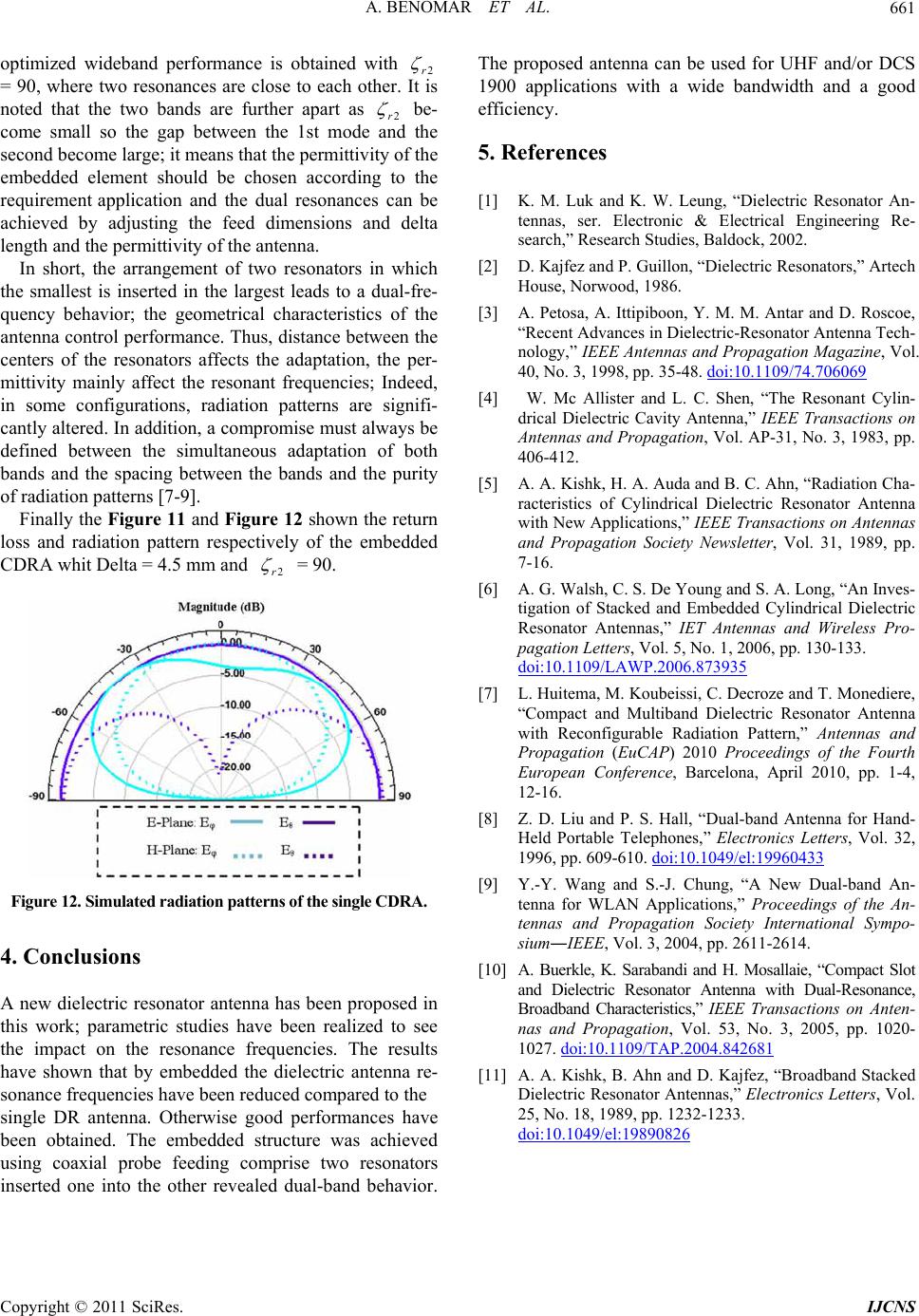
A. BENOMAR ET AL.661
optimized wideband performance is obtained with 2r
= 90, where two resonances are close to each other. It is
noted that the two bands are further apart as 2r
be-
come small so the gap between the 1st mode and
second become large; it means that the permittivity of the
embedded element should be chosen according the
requirement application and the dual resonances can be
achieved by adjusting the feed dimensions and delta
length and the permittivity of the an tenna.
In short, the arrangement of two resonators in which
the smallest is inserted in the largest leads to a dual-fre-
quency behavior; the geometrical charact
the
to
eristics of
an
and
the
tenna control performance. Thus, distance between the
centers of the resonators affects the adaptation, the per-
mittivity mainly affect the resonant frequencies; Indeed,
in some configurations, radiation patterns are signifi-
cantly altered. In addition, a co mpromise must always be
defined between the simultaneous adaptation of both
bands and the spacing between the bands and the purity
of radiation patterns [7-9] .
Finally the Figure 11 and Figure 12 shown the return
loss and radiation pattern respectively of the embedded
CDRA whit Delta = 4.5 mm2r
= 90.
Figure 12. Simulated rad iation patterns of th e single CDRA.
4. Conclusions
new dielectric resonator antenna has been proposed
studies have been realized to
e impact on the resonance frequencies. The results
ces
K. W. Leung, “Dielectric Resonator An-
tennas, ser. Electronic & Electrical Engineering Re-
ctric-Resonator Antenna Tech-
A in
this work; parametricsee
th
have shown that by embedded the dielectric antenna re-
sonance frequencies have been reduced compared to the
single DR antenna. Otherwise good performances have
been obtained. The embedded structure was achieved
using coaxial probe feeding comprise two resonators
inserted one into the other revealed dual-band behavior.
The proposed antenna can be used for UHF and/or DCS
1900 applications with a wide bandwidth and a good
efficiency.
5. Referen
[1] K. M. Luk and
search,” Research Studies, Baldock, 2002.
[2] D. Kajfez and P. Guillon, “Dielectric Resonators,” Artech
House, Norwood, 1986.
[3] A. Petosa, A. Ittipiboon, Y. M. M. Antar and D. Roscoe,
“Recent Advances in Diele
nology,” IEEE Antennas and Propagation Magazine, Vol.
40, No. 3, 1998, pp. 35-48. doi:10.1109/74.706069
[4] W. Mc Allister and L. C. Shen, “The Resonant Cylin-
drical Dielectric Cavity Antenna,” IEEE Transactions on
of Cylindrical Dielectric Resonator Antenna
n of Stacked and Embedded Cylindrical Dielectric
Antennas and Propagation, Vol. AP-31, No. 3, 1983, pp.
406-412.
[5] A. A. Kishk, H. A. Auda and B. C. Ahn, “Radiation Cha-
racteristics
with New Applications,” IEEE Transactions on Antennas
and Propagation Society Newsletter, Vol. 31, 1989, pp.
7-16.
[6] A. G. Walsh, C. S. De Young and S. A. Long, “An Inves-
tigatio
Resonator Antennas,” IET Antennas and Wireless Pro-
pagation Letters, Vol. 5, No. 1, 2006, pp. 130-133.
doi:10.1109/LAWP.2006.873935
[7] L. Huitema, M. Koubeissi, C. Decroze and T. Mone
“Compact and Multiband Dielectridiere,
c Resonator Antenna
rtable Telephones,” Electronics Letters, Vol. 32,
with Reconfigurable Radiation Pattern,” Antennas and
Propagation (EuCAP) 2010 Proceedings of the Fourth
European Conference, Barcelona, April 2010, pp. 1-4,
12-16.
[8] Z. D. Liu and P. S. Hall, “Dual-band Antenna for Hand-
Held Po
1996, pp. 609-610. doi:10.1049/el:19960433
[9] Y.-Y. Wang and S.-J. Chung, “A New Dual-band An-
tenna for WLAN Applications,” Proceedings of the An-
al-Resonance,
tennas and Propagation Society International Sympo-
sium―IEEE, Vol. 3, 2004, pp. 2611-2614.
[10] A. Buerkle, K. Sarabandi and H. Mosallaie, “Compact Slot
and Dielectric Resonator Antenna with Du
Broadband Characteristics,” IEEE Transactions on Anten-
nas and Propagation, Vol. 53, No. 3, 2005, pp. 1020-
1027. doi:10.1109/TAP.2004.842681
[11] A. A. Kishk, B. Ahn and D. Kajfez, “Broadband Stacked
Dielectric Resonator Antennas,” Electronics Letters, Vol.
25, No. 18, 1989, pp. 1232-1233.
doi:10.1049/el:19890826
Copyright © 2011 SciRes. IJCNS